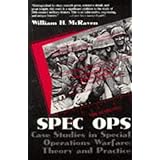
Average Reviews:

(More customer reviews)In "Spec Ops" William H. McRaven has written a comprehensive, thoughtful, theory of special operations. In so doing, he has taken a field of arms that is shrouded and myth and bravado, and applied rigorous logic to it; the end result of which is both a useful tool for the analysis of past operations, and a guidebook for future ones.
The key to this work's success is that it cuts through the mayhem, and "seat-of-their-pants" view that most people have of special operations, and breaks them down using simple, constant analysis. First McRaven considers the overall mission: Was it worth the risk? Was it executed according to plan, and if not why? What could have been done better? He then goes on to identify six key components of any special operation: Simplicity, Security, Repetition, Surprise, Speed and Purpose. He correctly points out that weakness in any one of these areas can be compensated for, to a degree, by strength in the others, but they all must be present to some degree.
Finally he considers the most critical aspect of any special operation; Did/can the attacking force achieve and maintain relative superiority over the enemy? I say critical because by definition the special forces will never have absolute superiority, it is only in their ability to temporarily achieve superiority that they can have any hope of success. McRaven, observes that failure to achieve relative superiority must inevitably result in a failure to achieve objectives at the minimum, and disaster at the worst.
By analyzing eight classic special operations, McRaven proves the merits of his theory time and again. Over the course of fifty years and a host of political environments, he illustrates the overarching validity of his arguments. In so doing he has provided both the special warrior, and the military historian alike with a powerful, valuable tool.
Click Here to see more reviews about: Spec Ops: Case Studies in Special Operations Warfare: Theory and Practice
Vice Adm. William H. McRaven helped to devise the strategy for how to bring down Osama bin Laden, and commanded the courageous U.S. military unit that carried it out on May 1, 2011, ending one of the greatest manhunts in history. In Spec Ops, a well-organized and deeply researched study, McRaven analyzes eight classic special operations. Six are from WWII: the German commando raid on the Belgian fort Eben Emael (1940); the Italian torpedo attack on the Alexandria harbor (1941); the British commando raid on Nazaire, France (1942); the German glider rescue of Benito Mussolini (1943); the British midget-submarine attack on the Tirpitz (1943); and the U.S. Ranger rescue mission at the Cabanatuan POW camp in the Philippines (1945). The two post-WWII examples are the U.S. Army raid on the Son Tay POW camp in North Vietnam (1970) and the Israeli rescue of the skyjacked hostages in Entebbe, Uganda (1976). McRaven—who commands a U.S. Navy SEAL team—pinpoints six essential principles of "spec ops" success: simplicity, security, repetition, surprise, speed and purpose. For each of the case studies, he provides political and military context, a meticulous reconstruction of the mission itself and an analysis of the operation in relation to his six principles. McRaven deems the Son Tay raid "the best modern example of a successful spec op [which] should be considered textbook material for future missions." His own book is an instructive textbook that will be closely studied by students of the military arts. Maps, photos.

0 comments:
Post a Comment